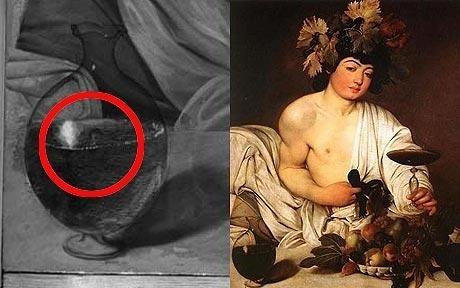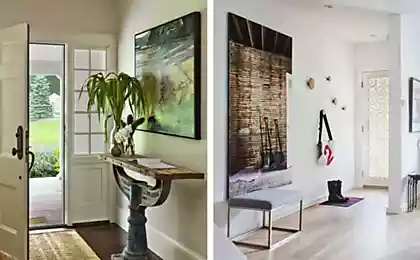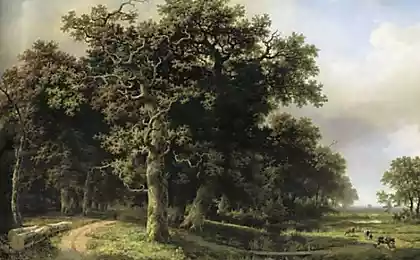534
7 secrets of great paintings uncovered with the help of latest technology
We admire the masterpieces of da Vinci, Rembrandt, Goya and Caravaggio, travel thousands of kilometers to admire the originals, photographed these pictures of cameras of smartphones, squeeze into tiny squares and inserted into snapcity or selfie. But technology can also help uncover the secrets lying beneath the surface of the painting.
With the help of advanced science and numerical simulation, modern scientists and critics can without ruining the paint to explore painting, learning something new about the master's life and the process of his work.
Technology is helping us to see beneath layers of paint the true feelings of the artist and even disguised jokes. In this article we have gathered seven surprising findings, first hidden from the world and history, and discovered with the help of new technologies.
Lady with an ermine
The work of Leonardo da Vinci's "Lady with an ermine" was remade twice, before you get your final look. According to BBC news, French engineer Pascal Cotte discovered that da Vinci changed the position of the forearm ladies and added symbolic ermine only in the third version of the film.
Using "the method of enhancing layers", a technique developed by him and his team, the cotta was covered by a picture of intense light and recorded reflections with mnogovintovoy camera.
"The method of enhancing layers gives us the opportunity to clear the painting like an onion, removing the surface to see what's going on inside and between the layers of paint," explained Cotte. The result? It turned out that paintings by the great da Vinci at times needed work.
An old man in military costume
Using macro x-ray fluorescence analysis, 380-year-old Rembrandt painting "Old man in military costume" was discovered portrait of a woman. The previously used method of infrared radiation wasn't strong enough to reveal underlying layers. Scientists explained this by the fact that Rembrandt used the same paint for the bottom "hidden" pictures and for the final.
Sacrifice West
Signed by Goya in the painting "the Sacrifice to Vesta" was detected using terahertz radiation. Although the 240-year-old painting was not a genuine documentary evidence of authorship, it was a turning point in the work of Goya.
In may 2013, scientists at the University of Barcelona studied the reflection of terahertz waves from the picture and found centuries hidden signed between the layers of paint in the lower right corner.
Bacchus
With the help of infrared radiation, scientists have discovered a tiny self-portrait of Caravaggio in his painting "Bacchus". In 1922, a version that picture is hidden under another painting. At the time, decided that it was the result of poor restoration, and due to insufficiently developed technology, the discussion came to naught.
However, the interest was seeded, and recently, scientists were able to use infrared reflectography to open a miniature-portrait of Caravaggio on the decanter of wine. We are waiting for the trailer for the film "Honey, I shrunk the Baroque master!".
Micropositioning stand
This new stand, developed by the Research Council engineering and physical Sciences, receives pictures pictures in high resolution, providing the opportunity to get to learn the techniques of artists and the Dating of the work with high accuracy. Micropositioning stand opens up opportunities for analysis of hyperspectral and other types of research.
The blue room
With the help of infrared radiation, the researchers got a picture of a bearded man in the bow tie, hidden under a painting by Pablo Picasso, 1901, "the Blue room".
X-ray analysis in the 1990s first allowed to smudged, hidden under the murky surface. Since 2008, Patricia Favero, associate, Phillips Collection, analyzed the picture using infrared radiation.
Not so long ago she released the most clear option. Now, using fluorescence spectroscopy, the team is working on refining the paint to restore a hidden picture in full color.
Flap herbs
In 2008, the research team Delphic University of Technology have discovered a mysterious portrait of a woman hidden in the painting of van Gogh's "Flap herbs". This finding confirmed the suspicions of many critics that something is under the "Flap herbs". Using x-ray fluorescence analysis reveals the chemical composition of the pigment, the researchers were able to determine exactly what kind of portrait lurks inside.published
P. S. And remember, only by changing their consumption — together we change the world! © Join us at Facebook , Vkontakte, Odnoklassniki
Source: mixstuff.ru/archives/95327
With the help of advanced science and numerical simulation, modern scientists and critics can without ruining the paint to explore painting, learning something new about the master's life and the process of his work.
Technology is helping us to see beneath layers of paint the true feelings of the artist and even disguised jokes. In this article we have gathered seven surprising findings, first hidden from the world and history, and discovered with the help of new technologies.
Lady with an ermine

The work of Leonardo da Vinci's "Lady with an ermine" was remade twice, before you get your final look. According to BBC news, French engineer Pascal Cotte discovered that da Vinci changed the position of the forearm ladies and added symbolic ermine only in the third version of the film.
Using "the method of enhancing layers", a technique developed by him and his team, the cotta was covered by a picture of intense light and recorded reflections with mnogovintovoy camera.
"The method of enhancing layers gives us the opportunity to clear the painting like an onion, removing the surface to see what's going on inside and between the layers of paint," explained Cotte. The result? It turned out that paintings by the great da Vinci at times needed work.
An old man in military costume

Using macro x-ray fluorescence analysis, 380-year-old Rembrandt painting "Old man in military costume" was discovered portrait of a woman. The previously used method of infrared radiation wasn't strong enough to reveal underlying layers. Scientists explained this by the fact that Rembrandt used the same paint for the bottom "hidden" pictures and for the final.
Sacrifice West

Signed by Goya in the painting "the Sacrifice to Vesta" was detected using terahertz radiation. Although the 240-year-old painting was not a genuine documentary evidence of authorship, it was a turning point in the work of Goya.
In may 2013, scientists at the University of Barcelona studied the reflection of terahertz waves from the picture and found centuries hidden signed between the layers of paint in the lower right corner.
Bacchus

With the help of infrared radiation, scientists have discovered a tiny self-portrait of Caravaggio in his painting "Bacchus". In 1922, a version that picture is hidden under another painting. At the time, decided that it was the result of poor restoration, and due to insufficiently developed technology, the discussion came to naught.
However, the interest was seeded, and recently, scientists were able to use infrared reflectography to open a miniature-portrait of Caravaggio on the decanter of wine. We are waiting for the trailer for the film "Honey, I shrunk the Baroque master!".
Micropositioning stand

This new stand, developed by the Research Council engineering and physical Sciences, receives pictures pictures in high resolution, providing the opportunity to get to learn the techniques of artists and the Dating of the work with high accuracy. Micropositioning stand opens up opportunities for analysis of hyperspectral and other types of research.
The blue room

With the help of infrared radiation, the researchers got a picture of a bearded man in the bow tie, hidden under a painting by Pablo Picasso, 1901, "the Blue room".
X-ray analysis in the 1990s first allowed to smudged, hidden under the murky surface. Since 2008, Patricia Favero, associate, Phillips Collection, analyzed the picture using infrared radiation.
Not so long ago she released the most clear option. Now, using fluorescence spectroscopy, the team is working on refining the paint to restore a hidden picture in full color.
Flap herbs

In 2008, the research team Delphic University of Technology have discovered a mysterious portrait of a woman hidden in the painting of van Gogh's "Flap herbs". This finding confirmed the suspicions of many critics that something is under the "Flap herbs". Using x-ray fluorescence analysis reveals the chemical composition of the pigment, the researchers were able to determine exactly what kind of portrait lurks inside.published
P. S. And remember, only by changing their consumption — together we change the world! © Join us at Facebook , Vkontakte, Odnoklassniki
Source: mixstuff.ru/archives/95327























